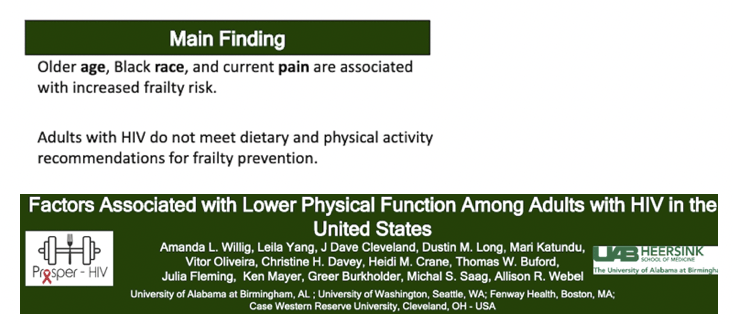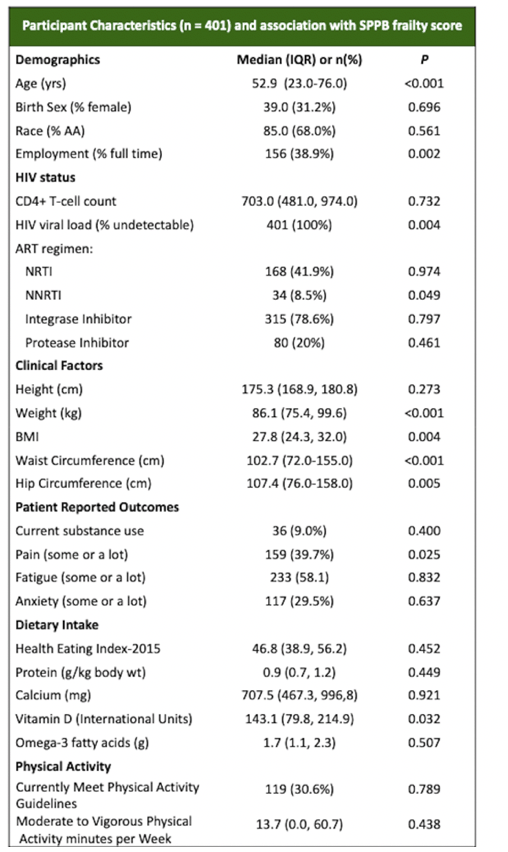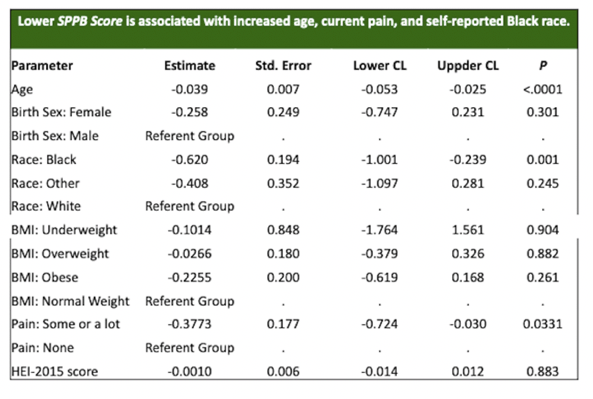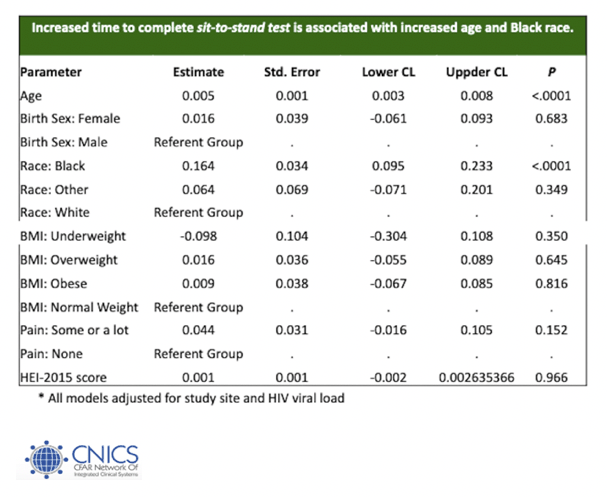 |
 |
 |
| |
Current Pain, Black Race, Age Tied to Higher Frailty Risk With HIV in USA
|
| |
| |
AIDS 2022, July 29-August 2, Montreal
Mark Mascolini
Although median age stood at only 53 years in a 401-person US group with HIV, more than 1 in 5 people ran a risk of frailty [1]. Current pain, black race, and older age predicted frailty by the Short Physical Performance Battery (SPPB). The PROSPER-HIV study also found that most of these adults with HIV don’t follow dietary or physical activity guidance for avoiding frailty.

Many studies confirm higher frailty rates in adults with HIV infection than in the general population. But little work has explored potential contributions of diet and activity to frailty or has tried to define frailty risk factors in people with HIV. Researchers working with the US CNICS cohort planned the PROSPER-HIV study partly to address these questions.
The analysis involved 401 HIV-positive men and women with a viral load below 200 copies while taking antiretroviral therapy. Participants completed three 24-hour diet recall assessments. The study used standard nutrient goals to prevent frailty: a Healthy Eating Index-2015 score at or above 80; dietary protein goal of 1.2 g/kg body weight; and recommended targets for daily calcium, vitamin D, and omega 3 fatty acids. Participants wore an Actigraph Accelerometer, which the researchers used to calculate steps per day, moderate to vigorous physical activity, and sedentary time.
The investigators assessed frailty by (1) grip strength, (2) SPPB (0 to 6 frail, 7 to 9 frailty risk, 10 to 12 not frail), and (3) 5 repeats of sit/stand chair test. They used multiple linear regression to explore associations between demographic and lifestyle variables and 3 outcomes: SPPB score, sit-to-stand time, and grip strength.
The study group included 307 men and 94 women. Most were 40 to 49 (20.2%), 50 to 59 (34.7%), or 60 to 69 (25.9%). Median age stood at 52.9 years (interquartile range 23.0 to 76.0) and was significantly associated with SPPB frailty score (P < 0.001). Median CD4 count measured 703, and all participants had an undetectable viral load.
Two thirds of participants, 68%, were black, and one third reported some form of food insecurity. While 9% reported current substance use, 39.7% reported at least some pain, 58.1% at least some fatigue, and 29.5% at least some anxiety.
Proportions with an SPPB score below 10 (indicating frailty or frailty risk) were 23.5% for women and 29.0% for men. Median steps per day were 4159 for women and 5416 for men. Only 30.6% of participants met current physical activity guidelines. On average, both women and men missed US protein and fiber goals by wide margins.
Linear regression analysis identified several independent predictors of the three frailty measures:
• Lower (worse) SPPB score was associated with older age (estimate -0.039, P < 0.001), current pain (estimate -0.3773, P = 0.0331), and black race (estimate -0.620, P = 0.001).
• Lower hand grip strength was associated with older age (estimate -0.242, P < 0.001), overweight body mass index (estimate 2.918, P = 0.042), and female birth sex (estimate -13.289, P < 0.001).
• Longer time to complete the sit-stand test was associated with older age (estimate 0.005, P < 0.001) and black race (estimate 0.164, P < 0.001).
The PROSPER-HIV investigators stressed that more than 1 in 5 study participants had frailty or ran a risk of frailty, even though median age was only 53 years. They underlined the findings that diet quality and physical activity “did not meet minimum standards for frailty prevention and cardiometabolic health.”
Reference
1. Willig AL, Yang L, Cleveland JD, et al. Factors associated with lower physical function among adults with HIV in the United States. AIDS 2022, July 29-August 2, Montreal. Abstract EPB102.







|
| |
|
 |
 |
|
|